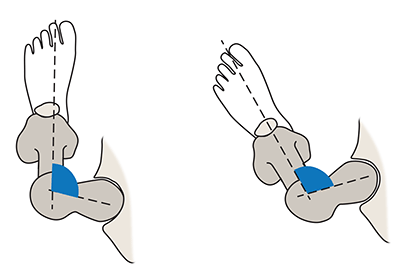Femoral Retroversion (Hip Retroversion)
The hip joint is where the femoral head (the top of the femur) meets the pelvis. In anatomy, the word "version" refers to the angle or rotation of all or part of an organ, bone or other structure in the body, relative to other structures in the body. Retroversion refers to an abnormal backward rotation of the hip relative to the knee. This condition can affect patients of all ages and leads to abnormal stress in the low back, hip and knee, as well as an abnormal gait (walking stance).
- What is femoral retroversion?
- What are the causes of femoral retroversion?
- What are the symptoms of femoral retroversion?
- How is femoral retroversion diagnosed?
- How is femoral retroversion treated?
What is femoral retroversion?
Femoral retroversion (also known as hip retroversion) is a rotational or torsional deformity in which the femur (thighbone) twists backward (outward) in relation to the knee. Because the lower part of the femur is connected to the knee, this also means that the knee is twisted outward relative to the hip.
The opposite condition, in which the femur has an abnormal forward (inward) rotation, is called femoral anteversion.
Femoral retroversion can occur in one or both legs. In some cases, hip/femoral retroversion may be combined with a separate torsional deformity, such as a rotation in the tibia.

Top-view illustrations of excessive femoral retroversion
Left: Position of a retroverted femoral head with the foot facing straight forward. In this position, the femoral head is not positioned normally in the hip joint. This can cause pain and abnormal force in the hip and can lead to degeneration and arthritis.
Right: Most patients with excessive hip retroversion compensate by walking out-toed. This position keeps the femoral head within the socket which minimizes pain.
What are the causes of femoral retroversion?
The exact cause of femoral retroversion is unknown. Femoral retroversion is often a congenital condition, meaning children are born with it. It also appears to be related to the position of the baby as it grows in the womb. Torsional deformity can also occur after a fracture, if a broken bone heals with incorrectly (called malunion).
Femoral retroversion often runs in families, which may indicate that some children have a higher risk of being born with this condition. Femoral retroversion may also occur after a physical trauma such as a femur fracture.
What are the symptoms of femoral retroversion?
Symptoms of femoral retroversion usually begin with the visual recognition of the rotated femur. However, in some cases, this may be difficult to identify, especially if femoral retroversion is combined with a separate rotation deformity such as tibial torsion.
Symptoms of femoral retroversion may include:
- out-toeing or "duck walk" – walking with the foot pointed outward instead of straight ahead
- learning to walk late (in children)
- flatfeet
- difficulty with running
- fatigues easily with physical activity
- poor balance or coordination
- hip and knee pain
- low back pain
- degeneration or arthritis of the hip
How is femoral retroversion diagnosed?
If femoral retroversion is suspected, a doctor will do a physical examination of the legs and hips in addition to a thorough medical, developmental and family history. The doctor will also observe the patient’s gait (manner of walking) to look for signs of out-toeing or gait compensation. The physician may also order an X-ray or CT scan to look for possible deformities.
Diagnosing femoral retroversion can sometimes be difficult, as the common positioning for X-ray imaging may not reveal a rotation in the femoral neck.
If the individual also has a separate rotational bone deformity such as internal tibial torsion – an inward rotation of the tibia (shinbone) – then femoral retroversion becomes even more difficult to diagnose. This is because opposite, incorrect rotations of the femur and tibia often leave the feet parallel during walking, which often makes the misalignment of the hips and knees go unnoticed.
How is femoral retroversion treated?
Many children born with femoral retroversion grow out it. For those who do not, a mild case may not cause significant health problems. In severe cases, however, surgery may be needed to correct the rotation.
An excessive femoral retroversion can place stress on hip and knee joints, often leading to joint pain and abnormal wear. In these situations, a surgical procedure known as a femoral osteotomy may be used. This surgery includes cutting and realigning the femur.
In some cases, a minimally invasive version of a femoral osteotomy may be performed. The femur bone is cut through a portal and an intramedullary rod is inserted into the marrow cavity of the bone. The torsional deformity is corrected by re-establishing the normal rotation between the hip and the knee. This procedure may be done for children over age 10 and adults and has a quick and reliable recovery.
Articles related to femoral retroversion
Updated: 3/2/2020
Reviewed and updated by S. Robert Rozbruch, MD

